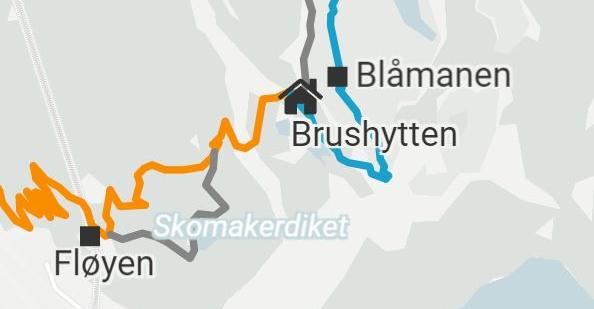On tour? The zones from “non-hello” to “hello” are not precise. Here are some observations.
-
Øivind Sørbø Johannessen
Bergen
This is a debate post. The entry was written by an external contributor, and quality assured by BT’s debate department. Opinions and analyzes are the writer’s own.
It is both strange and pleasant how this simple social and friendly “cheers” has become part of the greeting ritual when you meet strangers on a walk.
Exactly where the boundary between “hello” and “no-hello” lies is somewhat different among hikers. In some places it seems to be natural to greet visitors, while in other places it is perceived as both rude and intrusive.
It is nevertheless reasonable to assume that there are some invisible boundaries that can be mapped through actual observations.
Let us therefore start with a trip that starts in the city centre, with the aim of going up to Fløyen, further towards Rundemanen, over Vidden to Ulriken and from there Oppstemten down towards Landås:
Through the streets in the city center, it is neither natural nor socially acceptable – and almost considered breaking a social boundary – if you say “hello” to a stranger uninvited. It is also impractical with all the strangers you meet.
Above Fløysvingene is still not quite into greeting strangers. If you try a “hello”, it can undoubtedly be perceived as intrusive and rude.
Even when you’ve made it onto the Wing, it’s still not quite acceptable.

Further up towards Brushytten it starts to open up possibilities a little greeting, depending on which path you choose. The gravel road is not recommended, because there it is only exceptionally that a “hello” is considered acceptable.
If, on the other hand, you choose the hiking trail to Skomakerdiket, the opportunity for a social “hello” has opened up somewhat more. Here you probably won’t be seen as rude and pushy, but you can’t always expect to get a “hello” (and a smile) in return.
Further from Skomakerdiket and up the dirt road towards Brushytten, we are back in the slightly uncertain gray zone. A “hello” will not be seen as intrusive, while not allowing yourself a “hello” will not be perceived as rude either.
Do you greet passers-by on a trip?
From Brushytten has you two options: The asphalted northern road has certain “hello” restrictions, while the southern gravel path towards the top of Blåmanen allows for a friendly “hello” to a stranger.
Once you’ve passed the gravel and come onto the nature trail, something really starts to happen. Then normally a “hello” will be met with both a friendly “hello” and a smile in return. Now we are finally in a completely acceptable “hey” area. The same applies when you have reached the top of the paved north road to Rundemanen, and onto the rough stone path down towards the nature trail to Vidden.
At the crossroads between the gravel road down from Rundemanen, the stone road up from Tarlebø and the nature trail towards Vidden, the big thing happens. Then we have arrived there completely natural “hey area”. Here it is neither rude, unsocial, unacceptable or intrusive to greet. It is actually an area that is not only considered normal and completely inside, but now it is almost a mutual obligation to greet.

This positive, social duty of greeting now applies throughout Vidden and right up until there are a few hundred meters left to Ulriken’s top. There you enter a slightly more uncertain zone. Now the obligation to greet those present has gradually been lifted, and it is no longer required to “greet” while it is also not impolite not to.
Down The upvote remains The greeting area gets weaker and weaker the further down the stairs you go. When you then take the first steps out onto the gravel road and down the hill after the stone stairs, the “hello zone” ends completely. Then the “greeting tour” is at the end of the road, and you are back in the same dubious “greeting zone” as up to Fløyen.
And my conclusion on these observations?
In any case, we are social contact-seeking beings when we meet strangers in areas where there are few of us, while we are significantly less socially seeking towards strangers when we travel in areas where there are many of us.


![[해외 크리에이티브] 2023 Super Bowl Advertisement Settlement, Worst Edition [해외 크리에이티브] 2023 Super Bowl Advertisement Settlement, Worst Edition](http://www.madtimes.org/news/thumbnail/202302/16589_38037_3022_v150.jpg)